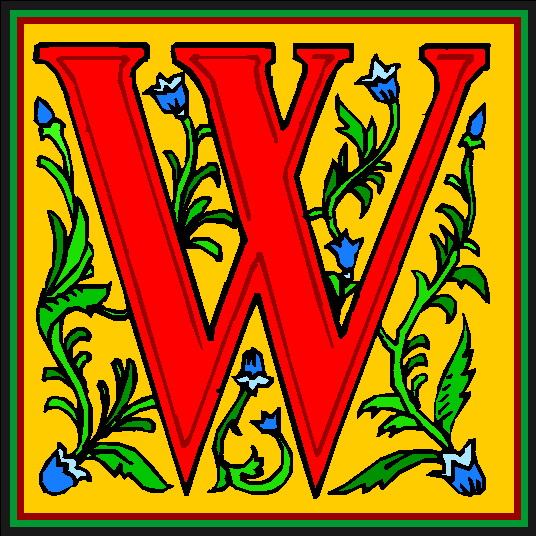 is
for Walstan of Bawburgh
is
for Walstan of Bawburgh is
for Walstan of Bawburgh
is
for Walstan of BawburghIf you had time to peruse the past issues of Bawburgh News, you would find endless references to the kindly Saint, usually to co-incide with the anniversary of his death on the 30th May 1016. During 1992 the Editor of the time, Betty Martins, visited many of the local images: stained glass windows at Kenninghall, Fritton and Great Melton; screen panels at Norwich, Litcham, Sparham, Ludham, Barnham Broom, Great Ryburgh and North Burlingham; a panelled chest at Denton, a wooden figure in the roof at Earl Stonham, a sculptured font at Saint Julians, Norwich, the sculptured image at the prayer cell, Bowthorpe, and the village signs at Bawburgh and Taverham. During this time, Carol Twinch was busy getting to grips with the origins of the Legend, and as a result of that and three further years of painstaking research, her book “In Search of Saint Walstan” was published near to Saint Walstan’s Day 1995. By the time of publication date, Carol had unearthed more evidence with the possibility of a wall painting of Walstan at Ashby, Suffolk; a destroyed Screen from Babingley, Norfolk; evidence of a Chapel and possible roof carving at Bury St. Edmunds; a screen panel at Gateley; a font carving at Gaywood; stained glass at St. Walstan’s Costessey, and Harvey’s funeral parlour (Costessey) and the very exciting find on the north wall of St. Andrew’s, Cavenham, Suffolk and even further afield, a panel at Foxearth, Essex, plus, and we thought finally, the late inclusion of Walberswick, necessitating a Postscript to the book! Not so—in the intervening years, Carol has kept Bawburgh News informed of changes to the list of Walstan images (the closest to home at St. Laurence in Norwich and the most distant in Kent), so much so, that a further publication “Saint with the Silver Shoes" followed in 2004. In 2016 yet a further book was published by Carol 'Saint Walstan the Third Search.' Saint Walstan Legend(Carol Twinch was Editor of Bawburgh News between 1983 and 1991).
The name of John Wagstaffe is synonymous with the Silver Spoon Legacy of Bawburgh, and the reason for the connection to Bawburgh by this distant historical figure, who was born in Basingstoke, is that he became a Baker in Norwich, and the Miller at Bawburgh. He followed the time of Jeremiah James Colman (who owned Bawburgh Mill in 1802, prior to commencing his famous mustard milling at Stoke Holy Cross). Not only was John Wagstaffe interested in natural history and was a poet, his religion as a Quaker was significantly reflected in his unique Will, which has become entrenched in Bawburgh’s history for nearly 200 years. In spite of their Catholic leanings, he was a friend and contemporary of the Jerninghams of Costessey Hall.
Some years ago, Bawburgh News covered the story of Wagstaffe and his Silver Spoons, which had been greatly helped by villager, Kathleen Browne, who had been the shopkeeper in Church Street, and had researched his story for a project for the W.I. She gleaned much from copies of his Will, and her article was reproduced. The manner of his legacy was that any couple married in Bawburgh Church should receive a silver spoon for their first born, provided the baby did not arrive before 36 weeks or later than two years after the marriage. He left a sum of £50 to be invested to provide such spoons. From 1809 until 1962 sixty-five babies received an engraved silver spoon (or the parents on its behalf). By this time, the interest on the capital invested became unviable to continue the charity.
On Saint Walstan’s Day 1999, Mr. Henry Ashby arrived in the village from Surrey, seeking out his family history—and announced that he was the six-times great grandson of John Wagstaffe. Henry Ashby’s four times great-grandfather was also the Bawburgh Miller — a Mr. Edward Candler — during the mid-1800s.
In 2000 Joyce Patterson arrived at Church Farmhouse for a Coffee Morning, as our Village Hall was being built and brought with her her rare Wagstaffe spoon as Joyce Mortimer (there were only another four presented after her).